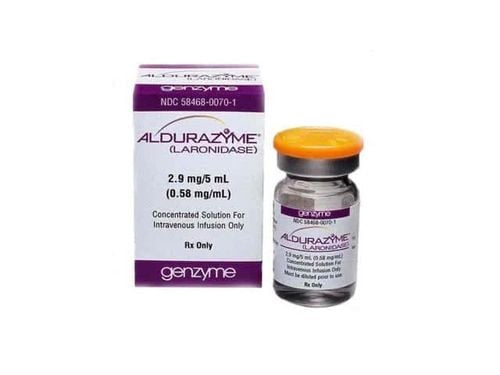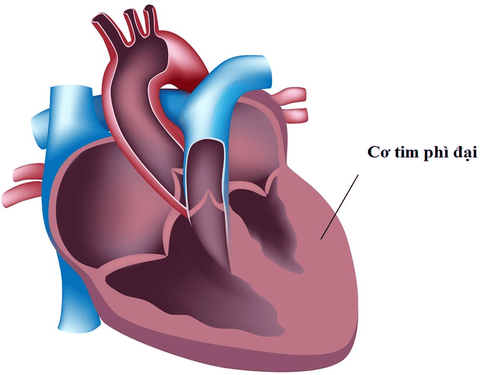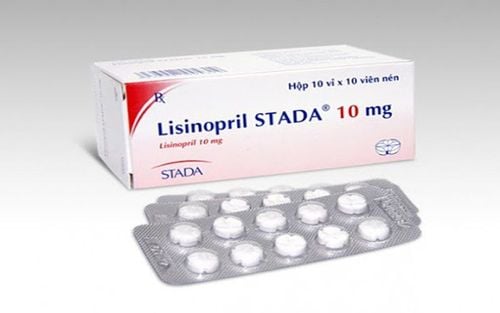This is an automatically translated article.
The article was professionally consulted with Doctor Cardiologist - Department of Medical Examination & Internal Medicine - Vinmec Hai Phong International General Hospital.
Mitral regurgitation is a fairly common cardiovascular disease, but not everyone knows about this disease. This article will clarify information about mitral regurgitation, what it is, its causes, symptoms and how to detect this disease.
1. What is mitral regurgitation?
Mitral regurgitation is a condition in which the mitral valve (one of the heart valves) is open, affecting the movement of blood in the heart, specifically, it causes blood to flow from the ventricle to the left atrium during stroke. systole. Because the mitral valve connects the left atrium and the left ventricle, the mitral valve normally opens during diastole to allow blood from the left atrium to flow into the left ventricle and closes during systole to prevent blood flow. from the left ventricle to the left atrium.
2. Causes of mitral regurgitation
Mitral valve has a structure including annulus, leaflets, ligaments and muscle columns. When abnormalities occur due to damage to any part of the upper structure, it can lead to mitral regurgitation.

2.1. Due to diseases of the valve leaflets
Due to sequelae of rheumatic heart disease causing fibrosis, thickening, calcification or retraction of the valve leaflets. Due to mucosal degeneration: often accompanied by excessive mobility such as sag, valve prolapse. Due to infective endocarditis, the leaflets perforate or cause the leaflets to contract. Mitral valve prolapse due to aortic regurgitation (caused by infective endocarditis) affecting the mitral valve. Due to atherosclerotic degeneration. Hypertrophic cardiomyopathy causes the mitral valve to move anteriorly during systole. Congenital disease: Patients with mitral valve dissection alone or in combination, also known as atrioventricular septal defect. Because the mitral valve has two valve holes.
2.2. Due to mitral annulus diseases
Due to dilation of the annulus: patients with left ventricular dilatation due to dilated cardiomyopathy, hypertension, ischemic heart disease. Due to calcification of the valve annulus: Due to degeneration in the elderly, can be promoted by hypertension, diabetes, kidney failure. Due to rheumatic heart disease, Hurler syndrome, Marfan syndrome.
2.3. Due to ligament diseases
Due to ligament degeneration causing ligament rupture. Due to sequelae of rheumatic heart disease causing thickening, adhesion, and calcification of ligaments.
2.4. Due to diseases of the musculoskeletal
Due to myocardial infarction, the papillary muscle column is ruptured. Due to papillary muscle dysfunction: Due to myocardial ischemia. Due to infiltrative heart disease such as sarcoid, amyloid.
2.5. Congenital
Malformation. Umbrella valve.
3. Symptoms of mitral regurgitation
In mild or moderate cases of mitral regurgitation, the patient may be asymptomatic. Even with severe cases of mitral regurgitation, in the early stages the patient does not have any symptoms until it leads to left heart failure, arrhythmia or pulmonary hypertension, then the patient has the symptoms.
3.1. Physical symptoms
For patients with acute mitral regurgitation with symptoms of pulmonary edema such as dyspnea at rest, lying down, or cardiogenic shock due to reduced ejection volume.
Patients with chronic mitral regurgitation will have the following symptoms:
The patient usually has no symptoms for many years except for a heart murmur. During the course of the disease, the patient presents from dyspnea on exertion to dyspnea on lying down and paroxysmal nocturnal dyspnoea. Later, the patient had symptoms of left heart failure as well as symptoms of right heart failure due to pulmonary hypertension. Patients may develop complete arrhythmias (atrial fibrillation): this is usually the result of left atrial dilatation. Patients feel fatigued due to decreased ejection volume and decreased cardiac output.
3.2. Physical symptoms
On physical examination, the physician may detect the following physical symptoms:
On palpation of the heart, the apex of the heart beats rapidly and briefly while the left ventricular function is good. The apex of the heart will shift to the left when the left ventricle is dilated. When auscultating the heart: Heart sounds have the following characteristics: T1 sound is often faint, sometimes normal. The T2 sound is often broad and strong in the presence of pulmonary hypertension. A T3 heart sound may occur in the presence of increased diastolic flow. In some cases, a T4 sound can be heard, especially during acute mitral regurgitation. Systolic murmur: appearing during the whole systole, high timbre, best heard at the apex, spreading to the armpit. If the left atrial pressure is too high, the sound will no longer be heard. In cases where the disease has led to left heart failure and right heart failure, the patient will have symptoms such as distended neck veins, hepatomegaly, ascites, and lower extremity edema.
4. How to detect mitral regurgitation?
4.1. Electrocardiogram (electrocardiogram)
On the results of the electrocardiogram showed non-specific signs such as:
Thickening of the left atrium. Thick left ventricle. Atrial flutter.
4.2. Chest X-ray
On chest X-ray film, the following images can be seen:
Image of left ventricle and left atrium dilatation in case of chronic mitral regurgitation. Images of interstitial edema and cystic edema in case of acute mitral regurgitation, or severe left ventricular failure.
4.3. Doppler echocardiography
Color Doppler ultrasound: shows the image of blood flow back to the left atrium, helping to diagnose mitral regurgitation. In addition, color Doppler ultrasound also provides many parameters to diagnose the extent of the disease such as: Area and width of retrograde blood flow. Continuous Doppler spectral intensity. Maximum velocity of flow through the mitral valve. Effective open area and open current volume. Mitral valve regurgitation can be estimated through the spread of retrograde blood into the left atrium, which is the usual calculation.
Pulsed Doppler ultrasound: helps to evaluate the degree of mitral regurgitation when using the Doppler window to determine the extent of blood flow back into the left atrium. Transthoracic echocardiography can also help evaluate: Assess the cause of mitral regurgitation. Calcification of the annulus, valve leaflets. Movement of the leaflets. Evaluation of the influence of mitral regurgitation on the chambers of the heart: assessment of the size and function of the heart chambers. It can be seen that echocardiography of mitral valve regurgitation by Doppler echocardiography technique plays a very important role, used to identify and evaluate the degree of mitral regurgitation. In cases where transthoracic echocardiography does not give a clear picture, the doctor can use transesophageal echocardiography to help see the mitral valve closer, more accurate assessment.
4.4. Cardiac catheterization and angiography
Cardiac angiography and hemodynamic studies should be done in the following cases:
Where non-invasive laboratory measures cannot be conclusive about the severity of mitral regurgitation, left ventricular function .... In case there is no similarity between clinical symptoms and non-invasive laboratory results in terms of severity of valve regurgitation. Coronary angiography is indicated in the following cases:
In case of suspected myocardial ischemia as the cause of mitral regurgitation. In case of planning mitral valve surgery for patients with angina attacks or patients with a history of myocardial infarction. In the case of planning mitral valve surgery for patients with 1 risk factor for coronary heart disease such as: Age. Dyslipidemia . Hypertension. Male patients > 40 years old and female patients > 50 years old, even without symptoms or risk factors for coronary artery disease, should have coronary angiography before surgery. Currently, Cardiovascular Center - Vinmec International General Hospital is one of the leading centers in the country for examination, diagnosis, screening and treatment of cardiovascular diseases. Vinmec not only has the convergence of a team of experienced and reputable leading experts in the field of surgical treatment, internal medicine, interventional cardiac catheterization, but also has a system of modern equipment, on par with The most prestigious hospitals in the world such as: MRI 3 Tesla (Siemens), CT 640 (Toshiba), high-end endoscopy equipment EVIS EXERA III (Olympus Japan), high anesthesia system Avace level, Hybrid operating room according to international standards... Especially, with the space designed according to 5-star hotel standards, Vinmec ensures to bring patients the most comfort, friendliness and peace of mind. .
Please dial HOTLINE for more information or register for an appointment HERE. Download MyVinmec app to make appointments faster and to manage your bookings easily.













